E-health Security: Security Challenges and Solutions in Healthcare
VerifiedAdded on 2023/01/06
|8
|2776
|88
Report
AI Summary
This report delves into the critical domain of e-health security, investigating its applications, inherent security challenges, and effective solutions. The report begins with an introduction to e-health, highlighting its reliance on digital technologies and the imperative of robust security measures in the healthcare sector. The main body explores the diverse applications of e-health, emphasizing its advantages in improving healthcare services and the importance of data management. It then examines the main security issues, including code injection, data breaches, malware injection, phishing, and hacking. The report also focuses on security solutions such as the use of firewalls, anti-virus software, strong passwords, two-factor authentication, and data encryption. The conclusion summarizes the importance of proactive security measures to protect patient data and ensure the continued advancement of e-health technologies. The report underscores the need for constant vigilance and adaptation to secure the healthcare sector against evolving cyber threats.
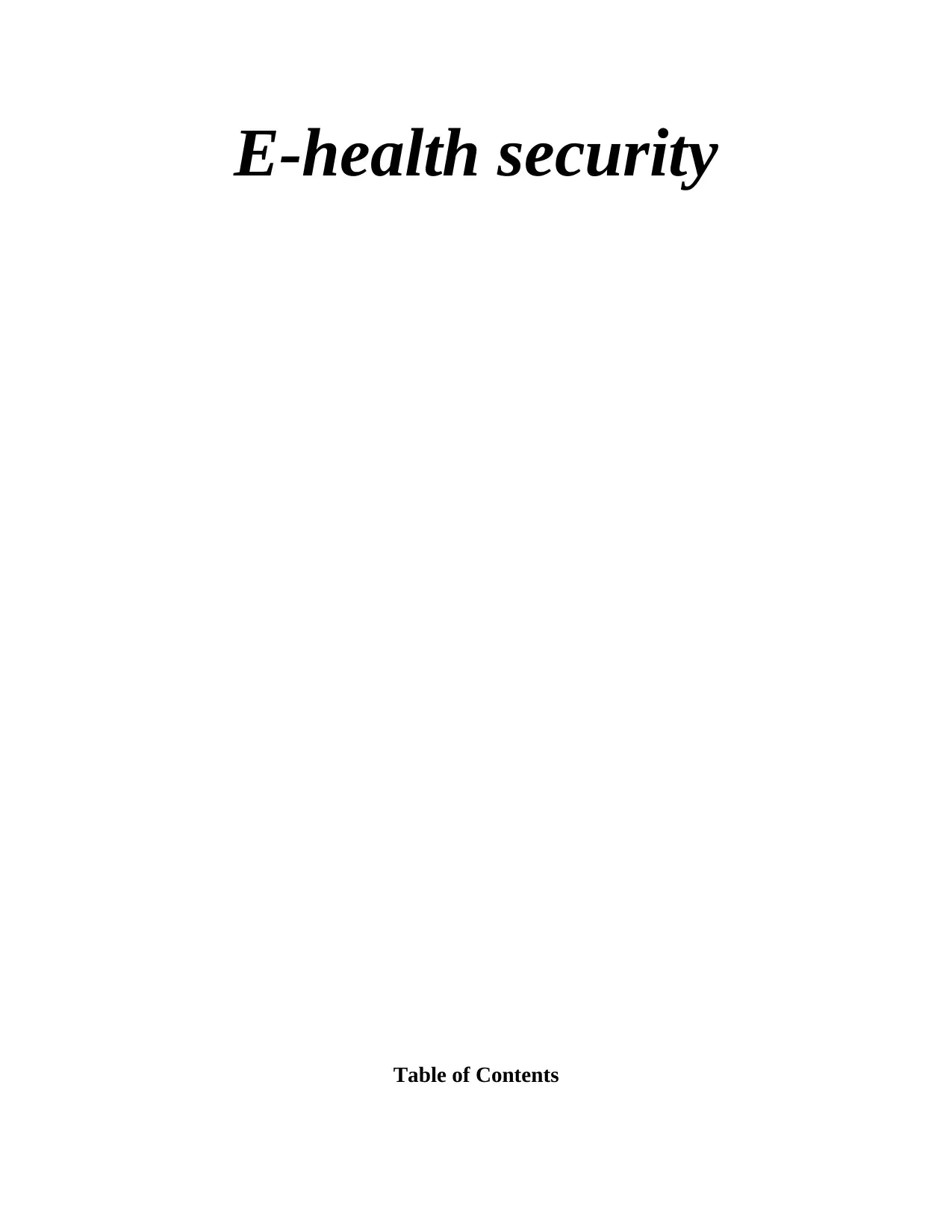
E-health security
Table of Contents
Table of Contents
Paraphrase This Document
Need a fresh take? Get an instant paraphrase of this document with our AI Paraphraser
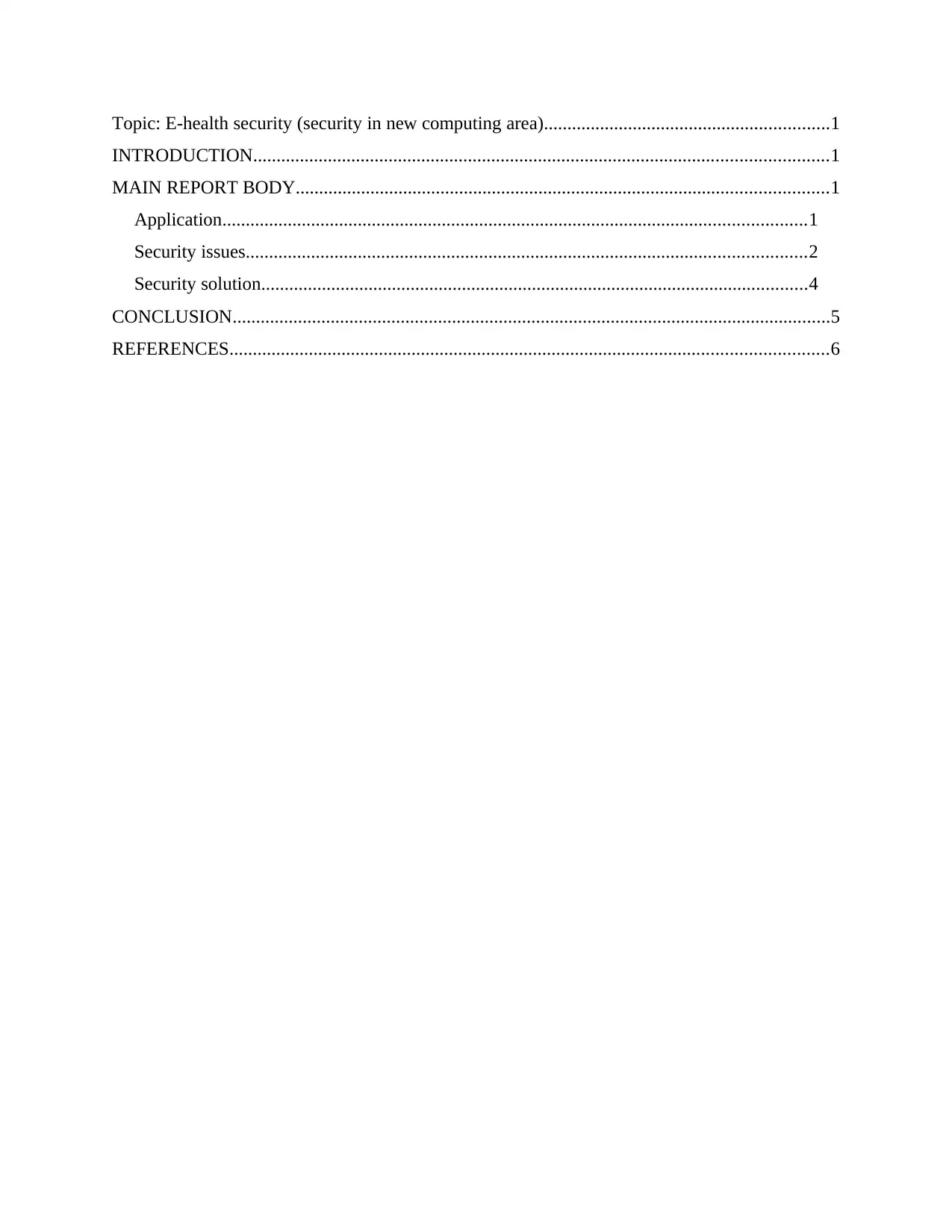
Topic: E-health security (security in new computing area).............................................................1
INTRODUCTION...........................................................................................................................1
MAIN REPORT BODY..................................................................................................................1
Application.............................................................................................................................1
Security issues........................................................................................................................2
Security solution.....................................................................................................................4
CONCLUSION................................................................................................................................5
REFERENCES................................................................................................................................6
INTRODUCTION...........................................................................................................................1
MAIN REPORT BODY..................................................................................................................1
Application.............................................................................................................................1
Security issues........................................................................................................................2
Security solution.....................................................................................................................4
CONCLUSION................................................................................................................................5
REFERENCES................................................................................................................................6
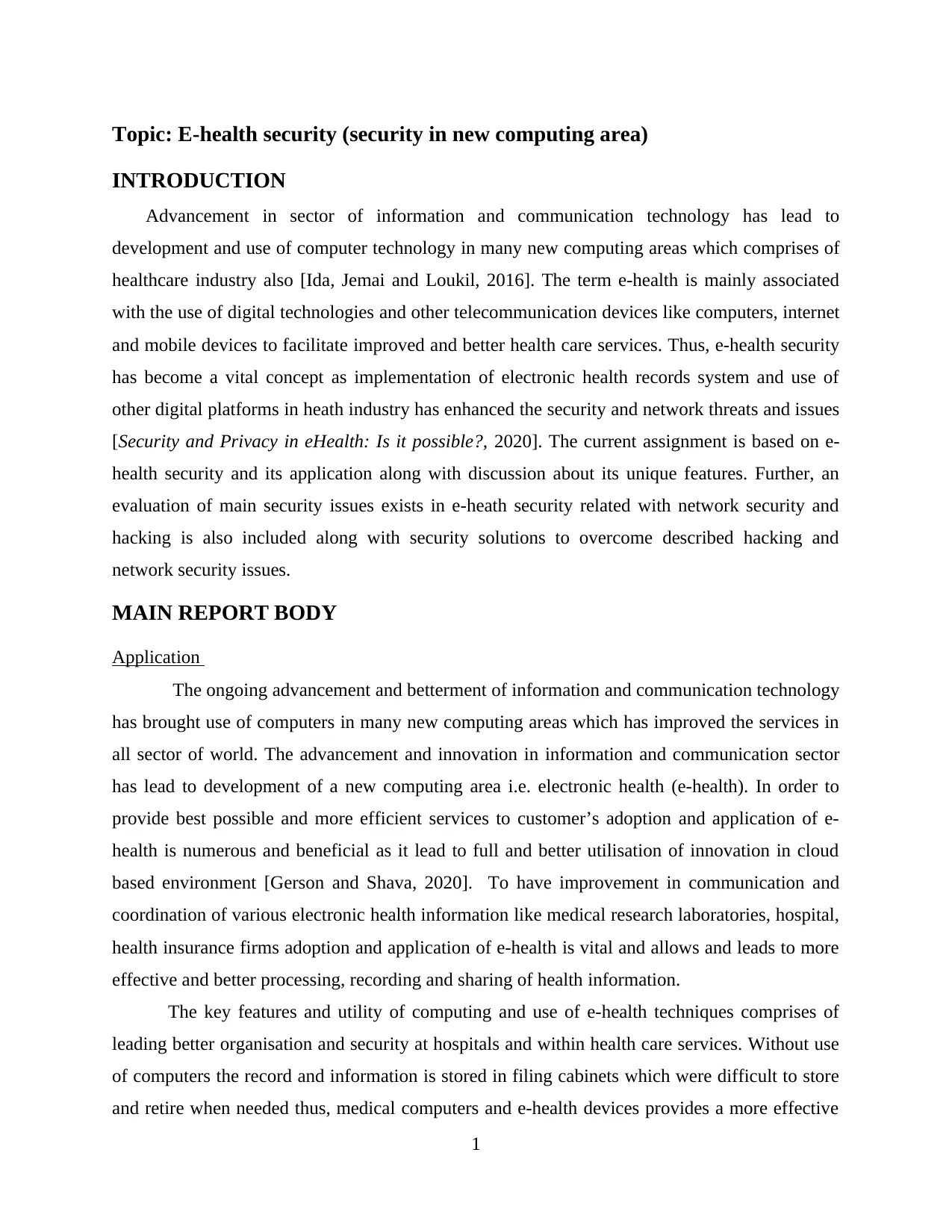
Topic: E-health security (security in new computing area)
INTRODUCTION
Advancement in sector of information and communication technology has lead to
development and use of computer technology in many new computing areas which comprises of
healthcare industry also [Ida, Jemai and Loukil, 2016]. The term e-health is mainly associated
with the use of digital technologies and other telecommunication devices like computers, internet
and mobile devices to facilitate improved and better health care services. Thus, e-health security
has become a vital concept as implementation of electronic health records system and use of
other digital platforms in heath industry has enhanced the security and network threats and issues
[Security and Privacy in eHealth: Is it possible?, 2020]. The current assignment is based on e-
health security and its application along with discussion about its unique features. Further, an
evaluation of main security issues exists in e-heath security related with network security and
hacking is also included along with security solutions to overcome described hacking and
network security issues.
MAIN REPORT BODY
Application
The ongoing advancement and betterment of information and communication technology
has brought use of computers in many new computing areas which has improved the services in
all sector of world. The advancement and innovation in information and communication sector
has lead to development of a new computing area i.e. electronic health (e-health). In order to
provide best possible and more efficient services to customer’s adoption and application of e-
health is numerous and beneficial as it lead to full and better utilisation of innovation in cloud
based environment [Gerson and Shava, 2020]. To have improvement in communication and
coordination of various electronic health information like medical research laboratories, hospital,
health insurance firms adoption and application of e-health is vital and allows and leads to more
effective and better processing, recording and sharing of health information.
The key features and utility of computing and use of e-health techniques comprises of
leading better organisation and security at hospitals and within health care services. Without use
of computers the record and information is stored in filing cabinets which were difficult to store
and retire when needed thus, medical computers and e-health devices provides a more effective
1
INTRODUCTION
Advancement in sector of information and communication technology has lead to
development and use of computer technology in many new computing areas which comprises of
healthcare industry also [Ida, Jemai and Loukil, 2016]. The term e-health is mainly associated
with the use of digital technologies and other telecommunication devices like computers, internet
and mobile devices to facilitate improved and better health care services. Thus, e-health security
has become a vital concept as implementation of electronic health records system and use of
other digital platforms in heath industry has enhanced the security and network threats and issues
[Security and Privacy in eHealth: Is it possible?, 2020]. The current assignment is based on e-
health security and its application along with discussion about its unique features. Further, an
evaluation of main security issues exists in e-heath security related with network security and
hacking is also included along with security solutions to overcome described hacking and
network security issues.
MAIN REPORT BODY
Application
The ongoing advancement and betterment of information and communication technology
has brought use of computers in many new computing areas which has improved the services in
all sector of world. The advancement and innovation in information and communication sector
has lead to development of a new computing area i.e. electronic health (e-health). In order to
provide best possible and more efficient services to customer’s adoption and application of e-
health is numerous and beneficial as it lead to full and better utilisation of innovation in cloud
based environment [Gerson and Shava, 2020]. To have improvement in communication and
coordination of various electronic health information like medical research laboratories, hospital,
health insurance firms adoption and application of e-health is vital and allows and leads to more
effective and better processing, recording and sharing of health information.
The key features and utility of computing and use of e-health techniques comprises of
leading better organisation and security at hospitals and within health care services. Without use
of computers the record and information is stored in filing cabinets which were difficult to store
and retire when needed thus, medical computers and e-health devices provides a more effective
1
⊘ This is a preview!⊘
Do you want full access?
Subscribe today to unlock all pages.

Trusted by 1+ million students worldwide
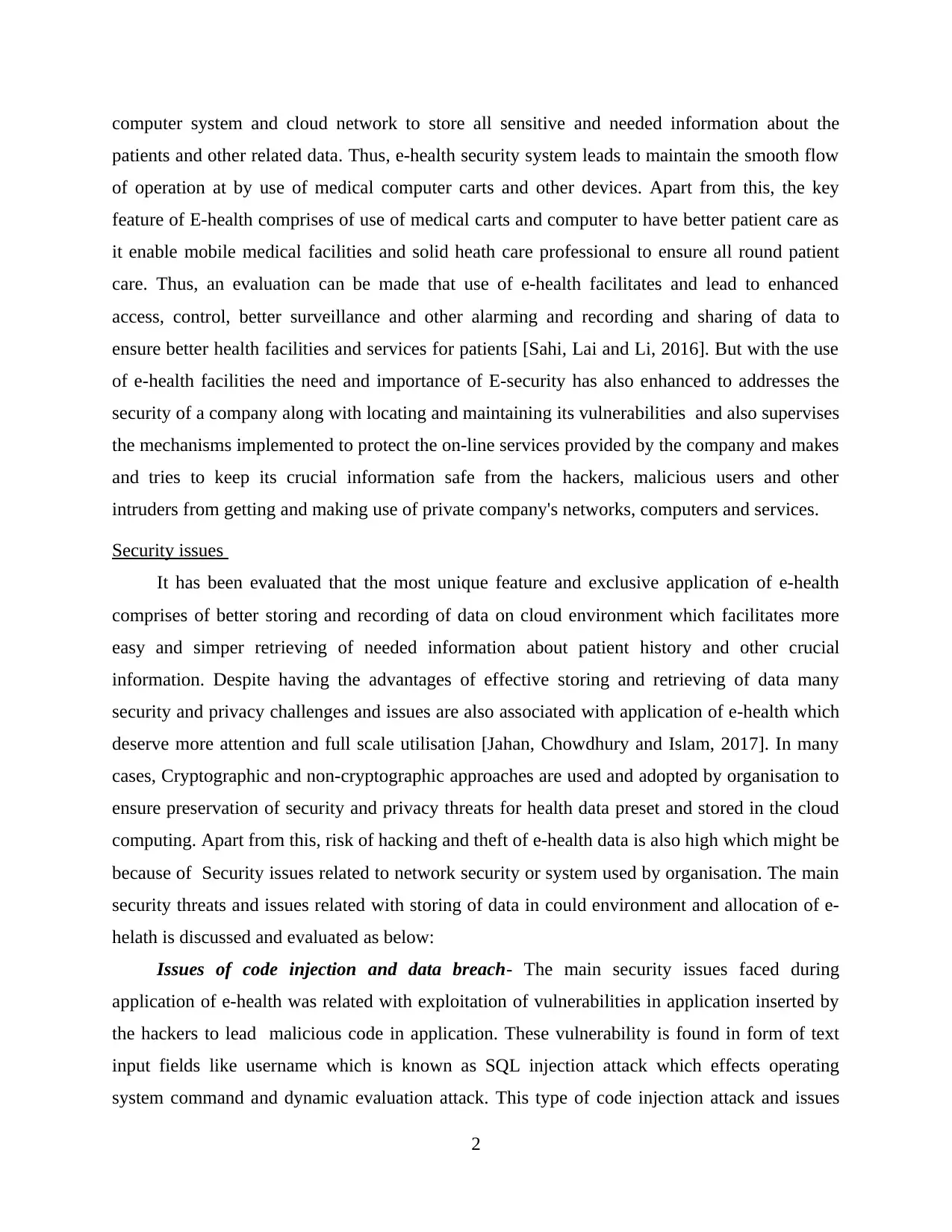
computer system and cloud network to store all sensitive and needed information about the
patients and other related data. Thus, e-health security system leads to maintain the smooth flow
of operation at by use of medical computer carts and other devices. Apart from this, the key
feature of E-health comprises of use of medical carts and computer to have better patient care as
it enable mobile medical facilities and solid heath care professional to ensure all round patient
care. Thus, an evaluation can be made that use of e-health facilitates and lead to enhanced
access, control, better surveillance and other alarming and recording and sharing of data to
ensure better health facilities and services for patients [Sahi, Lai and Li, 2016]. But with the use
of e-health facilities the need and importance of E-security has also enhanced to addresses the
security of a company along with locating and maintaining its vulnerabilities and also supervises
the mechanisms implemented to protect the on-line services provided by the company and makes
and tries to keep its crucial information safe from the hackers, malicious users and other
intruders from getting and making use of private company's networks, computers and services.
Security issues
It has been evaluated that the most unique feature and exclusive application of e-health
comprises of better storing and recording of data on cloud environment which facilitates more
easy and simper retrieving of needed information about patient history and other crucial
information. Despite having the advantages of effective storing and retrieving of data many
security and privacy challenges and issues are also associated with application of e-health which
deserve more attention and full scale utilisation [Jahan, Chowdhury and Islam, 2017]. In many
cases, Cryptographic and non-cryptographic approaches are used and adopted by organisation to
ensure preservation of security and privacy threats for health data preset and stored in the cloud
computing. Apart from this, risk of hacking and theft of e-health data is also high which might be
because of Security issues related to network security or system used by organisation. The main
security threats and issues related with storing of data in could environment and allocation of e-
helath is discussed and evaluated as below:
Issues of code injection and data breach- The main security issues faced during
application of e-health was related with exploitation of vulnerabilities in application inserted by
the hackers to lead malicious code in application. These vulnerability is found in form of text
input fields like username which is known as SQL injection attack which effects operating
system command and dynamic evaluation attack. This type of code injection attack and issues
2
patients and other related data. Thus, e-health security system leads to maintain the smooth flow
of operation at by use of medical computer carts and other devices. Apart from this, the key
feature of E-health comprises of use of medical carts and computer to have better patient care as
it enable mobile medical facilities and solid heath care professional to ensure all round patient
care. Thus, an evaluation can be made that use of e-health facilitates and lead to enhanced
access, control, better surveillance and other alarming and recording and sharing of data to
ensure better health facilities and services for patients [Sahi, Lai and Li, 2016]. But with the use
of e-health facilities the need and importance of E-security has also enhanced to addresses the
security of a company along with locating and maintaining its vulnerabilities and also supervises
the mechanisms implemented to protect the on-line services provided by the company and makes
and tries to keep its crucial information safe from the hackers, malicious users and other
intruders from getting and making use of private company's networks, computers and services.
Security issues
It has been evaluated that the most unique feature and exclusive application of e-health
comprises of better storing and recording of data on cloud environment which facilitates more
easy and simper retrieving of needed information about patient history and other crucial
information. Despite having the advantages of effective storing and retrieving of data many
security and privacy challenges and issues are also associated with application of e-health which
deserve more attention and full scale utilisation [Jahan, Chowdhury and Islam, 2017]. In many
cases, Cryptographic and non-cryptographic approaches are used and adopted by organisation to
ensure preservation of security and privacy threats for health data preset and stored in the cloud
computing. Apart from this, risk of hacking and theft of e-health data is also high which might be
because of Security issues related to network security or system used by organisation. The main
security threats and issues related with storing of data in could environment and allocation of e-
helath is discussed and evaluated as below:
Issues of code injection and data breach- The main security issues faced during
application of e-health was related with exploitation of vulnerabilities in application inserted by
the hackers to lead malicious code in application. These vulnerability is found in form of text
input fields like username which is known as SQL injection attack which effects operating
system command and dynamic evaluation attack. This type of code injection attack and issues
2
Paraphrase This Document
Need a fresh take? Get an instant paraphrase of this document with our AI Paraphraser
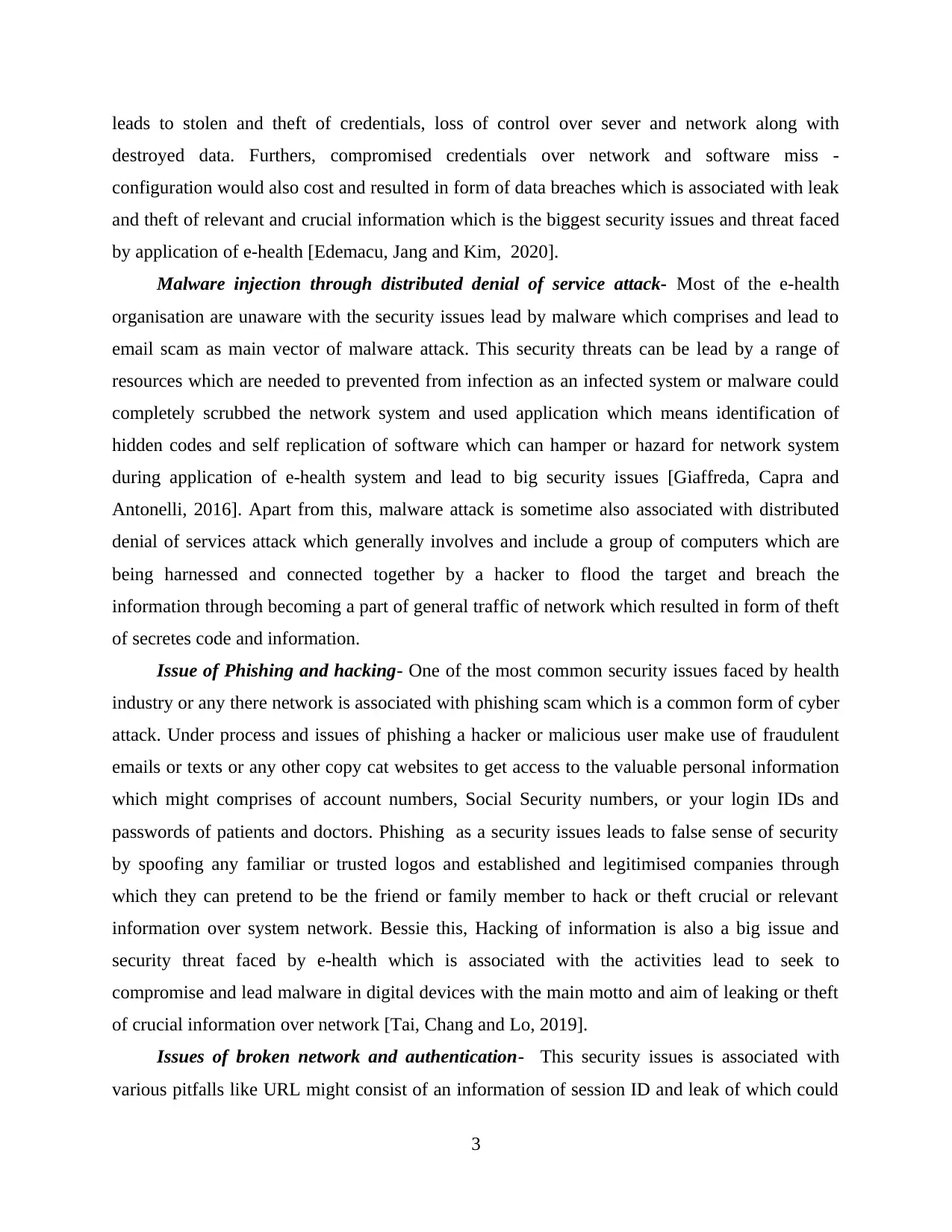
leads to stolen and theft of credentials, loss of control over sever and network along with
destroyed data. Furthers, compromised credentials over network and software miss -
configuration would also cost and resulted in form of data breaches which is associated with leak
and theft of relevant and crucial information which is the biggest security issues and threat faced
by application of e-health [Edemacu, Jang and Kim, 2020].
Malware injection through distributed denial of service attack- Most of the e-health
organisation are unaware with the security issues lead by malware which comprises and lead to
email scam as main vector of malware attack. This security threats can be lead by a range of
resources which are needed to prevented from infection as an infected system or malware could
completely scrubbed the network system and used application which means identification of
hidden codes and self replication of software which can hamper or hazard for network system
during application of e-health system and lead to big security issues [Giaffreda, Capra and
Antonelli, 2016]. Apart from this, malware attack is sometime also associated with distributed
denial of services attack which generally involves and include a group of computers which are
being harnessed and connected together by a hacker to flood the target and breach the
information through becoming a part of general traffic of network which resulted in form of theft
of secretes code and information.
Issue of Phishing and hacking- One of the most common security issues faced by health
industry or any there network is associated with phishing scam which is a common form of cyber
attack. Under process and issues of phishing a hacker or malicious user make use of fraudulent
emails or texts or any other copy cat websites to get access to the valuable personal information
which might comprises of account numbers, Social Security numbers, or your login IDs and
passwords of patients and doctors. Phishing as a security issues leads to false sense of security
by spoofing any familiar or trusted logos and established and legitimised companies through
which they can pretend to be the friend or family member to hack or theft crucial or relevant
information over system network. Bessie this, Hacking of information is also a big issue and
security threat faced by e-health which is associated with the activities lead to seek to
compromise and lead malware in digital devices with the main motto and aim of leaking or theft
of crucial information over network [Tai, Chang and Lo, 2019].
Issues of broken network and authentication- This security issues is associated with
various pitfalls like URL might consist of an information of session ID and leak of which could
3
destroyed data. Furthers, compromised credentials over network and software miss -
configuration would also cost and resulted in form of data breaches which is associated with leak
and theft of relevant and crucial information which is the biggest security issues and threat faced
by application of e-health [Edemacu, Jang and Kim, 2020].
Malware injection through distributed denial of service attack- Most of the e-health
organisation are unaware with the security issues lead by malware which comprises and lead to
email scam as main vector of malware attack. This security threats can be lead by a range of
resources which are needed to prevented from infection as an infected system or malware could
completely scrubbed the network system and used application which means identification of
hidden codes and self replication of software which can hamper or hazard for network system
during application of e-health system and lead to big security issues [Giaffreda, Capra and
Antonelli, 2016]. Apart from this, malware attack is sometime also associated with distributed
denial of services attack which generally involves and include a group of computers which are
being harnessed and connected together by a hacker to flood the target and breach the
information through becoming a part of general traffic of network which resulted in form of theft
of secretes code and information.
Issue of Phishing and hacking- One of the most common security issues faced by health
industry or any there network is associated with phishing scam which is a common form of cyber
attack. Under process and issues of phishing a hacker or malicious user make use of fraudulent
emails or texts or any other copy cat websites to get access to the valuable personal information
which might comprises of account numbers, Social Security numbers, or your login IDs and
passwords of patients and doctors. Phishing as a security issues leads to false sense of security
by spoofing any familiar or trusted logos and established and legitimised companies through
which they can pretend to be the friend or family member to hack or theft crucial or relevant
information over system network. Bessie this, Hacking of information is also a big issue and
security threat faced by e-health which is associated with the activities lead to seek to
compromise and lead malware in digital devices with the main motto and aim of leaking or theft
of crucial information over network [Tai, Chang and Lo, 2019].
Issues of broken network and authentication- This security issues is associated with
various pitfalls like URL might consist of an information of session ID and leak of which could
3
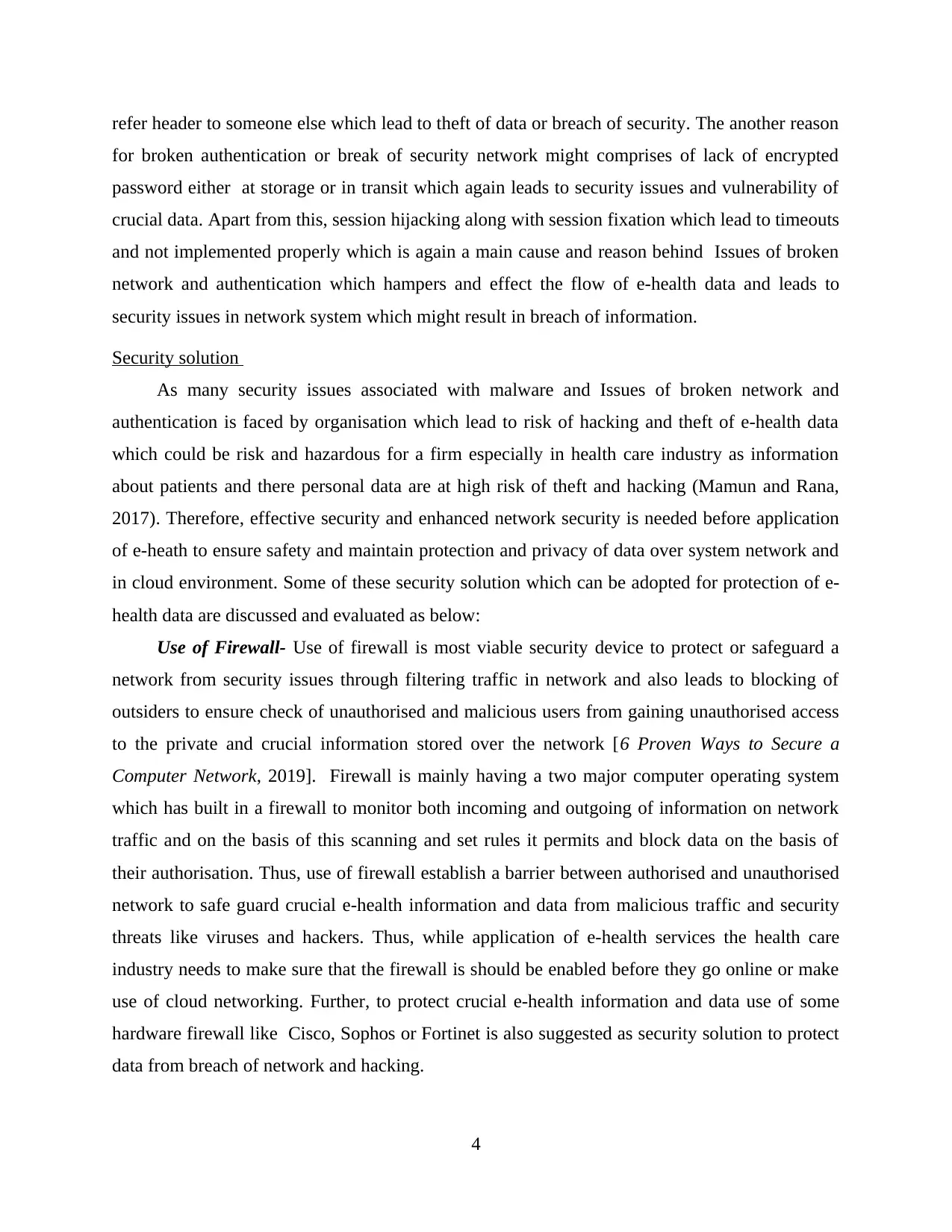
refer header to someone else which lead to theft of data or breach of security. The another reason
for broken authentication or break of security network might comprises of lack of encrypted
password either at storage or in transit which again leads to security issues and vulnerability of
crucial data. Apart from this, session hijacking along with session fixation which lead to timeouts
and not implemented properly which is again a main cause and reason behind Issues of broken
network and authentication which hampers and effect the flow of e-health data and leads to
security issues in network system which might result in breach of information.
Security solution
As many security issues associated with malware and Issues of broken network and
authentication is faced by organisation which lead to risk of hacking and theft of e-health data
which could be risk and hazardous for a firm especially in health care industry as information
about patients and there personal data are at high risk of theft and hacking (Mamun and Rana,
2017). Therefore, effective security and enhanced network security is needed before application
of e-heath to ensure safety and maintain protection and privacy of data over system network and
in cloud environment. Some of these security solution which can be adopted for protection of e-
health data are discussed and evaluated as below:
Use of Firewall- Use of firewall is most viable security device to protect or safeguard a
network from security issues through filtering traffic in network and also leads to blocking of
outsiders to ensure check of unauthorised and malicious users from gaining unauthorised access
to the private and crucial information stored over the network [6 Proven Ways to Secure a
Computer Network, 2019]. Firewall is mainly having a two major computer operating system
which has built in a firewall to monitor both incoming and outgoing of information on network
traffic and on the basis of this scanning and set rules it permits and block data on the basis of
their authorisation. Thus, use of firewall establish a barrier between authorised and unauthorised
network to safe guard crucial e-health information and data from malicious traffic and security
threats like viruses and hackers. Thus, while application of e-health services the health care
industry needs to make sure that the firewall is should be enabled before they go online or make
use of cloud networking. Further, to protect crucial e-health information and data use of some
hardware firewall like Cisco, Sophos or Fortinet is also suggested as security solution to protect
data from breach of network and hacking.
4
for broken authentication or break of security network might comprises of lack of encrypted
password either at storage or in transit which again leads to security issues and vulnerability of
crucial data. Apart from this, session hijacking along with session fixation which lead to timeouts
and not implemented properly which is again a main cause and reason behind Issues of broken
network and authentication which hampers and effect the flow of e-health data and leads to
security issues in network system which might result in breach of information.
Security solution
As many security issues associated with malware and Issues of broken network and
authentication is faced by organisation which lead to risk of hacking and theft of e-health data
which could be risk and hazardous for a firm especially in health care industry as information
about patients and there personal data are at high risk of theft and hacking (Mamun and Rana,
2017). Therefore, effective security and enhanced network security is needed before application
of e-heath to ensure safety and maintain protection and privacy of data over system network and
in cloud environment. Some of these security solution which can be adopted for protection of e-
health data are discussed and evaluated as below:
Use of Firewall- Use of firewall is most viable security device to protect or safeguard a
network from security issues through filtering traffic in network and also leads to blocking of
outsiders to ensure check of unauthorised and malicious users from gaining unauthorised access
to the private and crucial information stored over the network [6 Proven Ways to Secure a
Computer Network, 2019]. Firewall is mainly having a two major computer operating system
which has built in a firewall to monitor both incoming and outgoing of information on network
traffic and on the basis of this scanning and set rules it permits and block data on the basis of
their authorisation. Thus, use of firewall establish a barrier between authorised and unauthorised
network to safe guard crucial e-health information and data from malicious traffic and security
threats like viruses and hackers. Thus, while application of e-health services the health care
industry needs to make sure that the firewall is should be enabled before they go online or make
use of cloud networking. Further, to protect crucial e-health information and data use of some
hardware firewall like Cisco, Sophos or Fortinet is also suggested as security solution to protect
data from breach of network and hacking.
4
⊘ This is a preview!⊘
Do you want full access?
Subscribe today to unlock all pages.

Trusted by 1+ million students worldwide
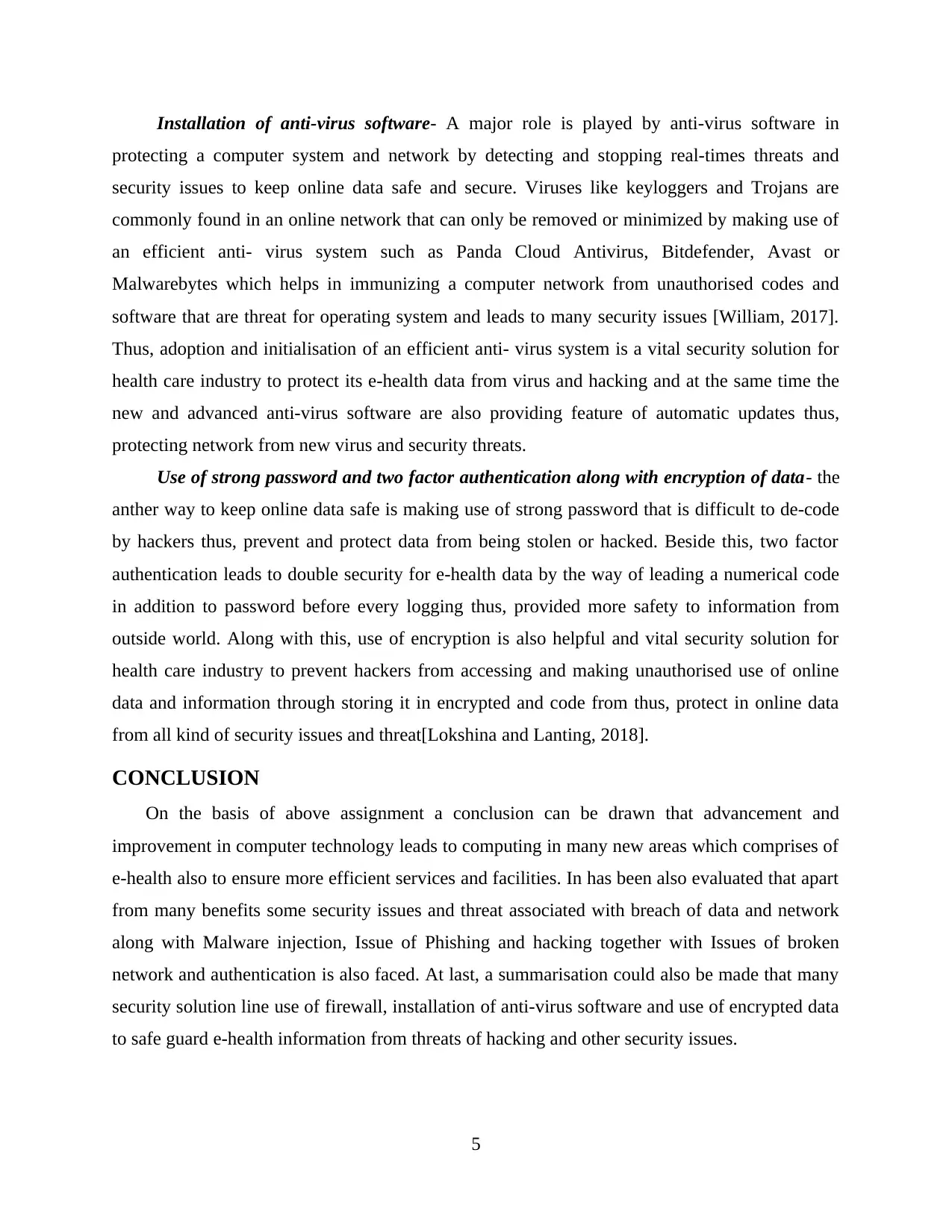
Installation of anti-virus software- A major role is played by anti-virus software in
protecting a computer system and network by detecting and stopping real-times threats and
security issues to keep online data safe and secure. Viruses like keyloggers and Trojans are
commonly found in an online network that can only be removed or minimized by making use of
an efficient anti- virus system such as Panda Cloud Antivirus, Bitdefender, Avast or
Malwarebytes which helps in immunizing a computer network from unauthorised codes and
software that are threat for operating system and leads to many security issues [William, 2017].
Thus, adoption and initialisation of an efficient anti- virus system is a vital security solution for
health care industry to protect its e-health data from virus and hacking and at the same time the
new and advanced anti-virus software are also providing feature of automatic updates thus,
protecting network from new virus and security threats.
Use of strong password and two factor authentication along with encryption of data- the
anther way to keep online data safe is making use of strong password that is difficult to de-code
by hackers thus, prevent and protect data from being stolen or hacked. Beside this, two factor
authentication leads to double security for e-health data by the way of leading a numerical code
in addition to password before every logging thus, provided more safety to information from
outside world. Along with this, use of encryption is also helpful and vital security solution for
health care industry to prevent hackers from accessing and making unauthorised use of online
data and information through storing it in encrypted and code from thus, protect in online data
from all kind of security issues and threat[Lokshina and Lanting, 2018].
CONCLUSION
On the basis of above assignment a conclusion can be drawn that advancement and
improvement in computer technology leads to computing in many new areas which comprises of
e-health also to ensure more efficient services and facilities. In has been also evaluated that apart
from many benefits some security issues and threat associated with breach of data and network
along with Malware injection, Issue of Phishing and hacking together with Issues of broken
network and authentication is also faced. At last, a summarisation could also be made that many
security solution line use of firewall, installation of anti-virus software and use of encrypted data
to safe guard e-health information from threats of hacking and other security issues.
5
protecting a computer system and network by detecting and stopping real-times threats and
security issues to keep online data safe and secure. Viruses like keyloggers and Trojans are
commonly found in an online network that can only be removed or minimized by making use of
an efficient anti- virus system such as Panda Cloud Antivirus, Bitdefender, Avast or
Malwarebytes which helps in immunizing a computer network from unauthorised codes and
software that are threat for operating system and leads to many security issues [William, 2017].
Thus, adoption and initialisation of an efficient anti- virus system is a vital security solution for
health care industry to protect its e-health data from virus and hacking and at the same time the
new and advanced anti-virus software are also providing feature of automatic updates thus,
protecting network from new virus and security threats.
Use of strong password and two factor authentication along with encryption of data- the
anther way to keep online data safe is making use of strong password that is difficult to de-code
by hackers thus, prevent and protect data from being stolen or hacked. Beside this, two factor
authentication leads to double security for e-health data by the way of leading a numerical code
in addition to password before every logging thus, provided more safety to information from
outside world. Along with this, use of encryption is also helpful and vital security solution for
health care industry to prevent hackers from accessing and making unauthorised use of online
data and information through storing it in encrypted and code from thus, protect in online data
from all kind of security issues and threat[Lokshina and Lanting, 2018].
CONCLUSION
On the basis of above assignment a conclusion can be drawn that advancement and
improvement in computer technology leads to computing in many new areas which comprises of
e-health also to ensure more efficient services and facilities. In has been also evaluated that apart
from many benefits some security issues and threat associated with breach of data and network
along with Malware injection, Issue of Phishing and hacking together with Issues of broken
network and authentication is also faced. At last, a summarisation could also be made that many
security solution line use of firewall, installation of anti-virus software and use of encrypted data
to safe guard e-health information from threats of hacking and other security issues.
5
Paraphrase This Document
Need a fresh take? Get an instant paraphrase of this document with our AI Paraphraser
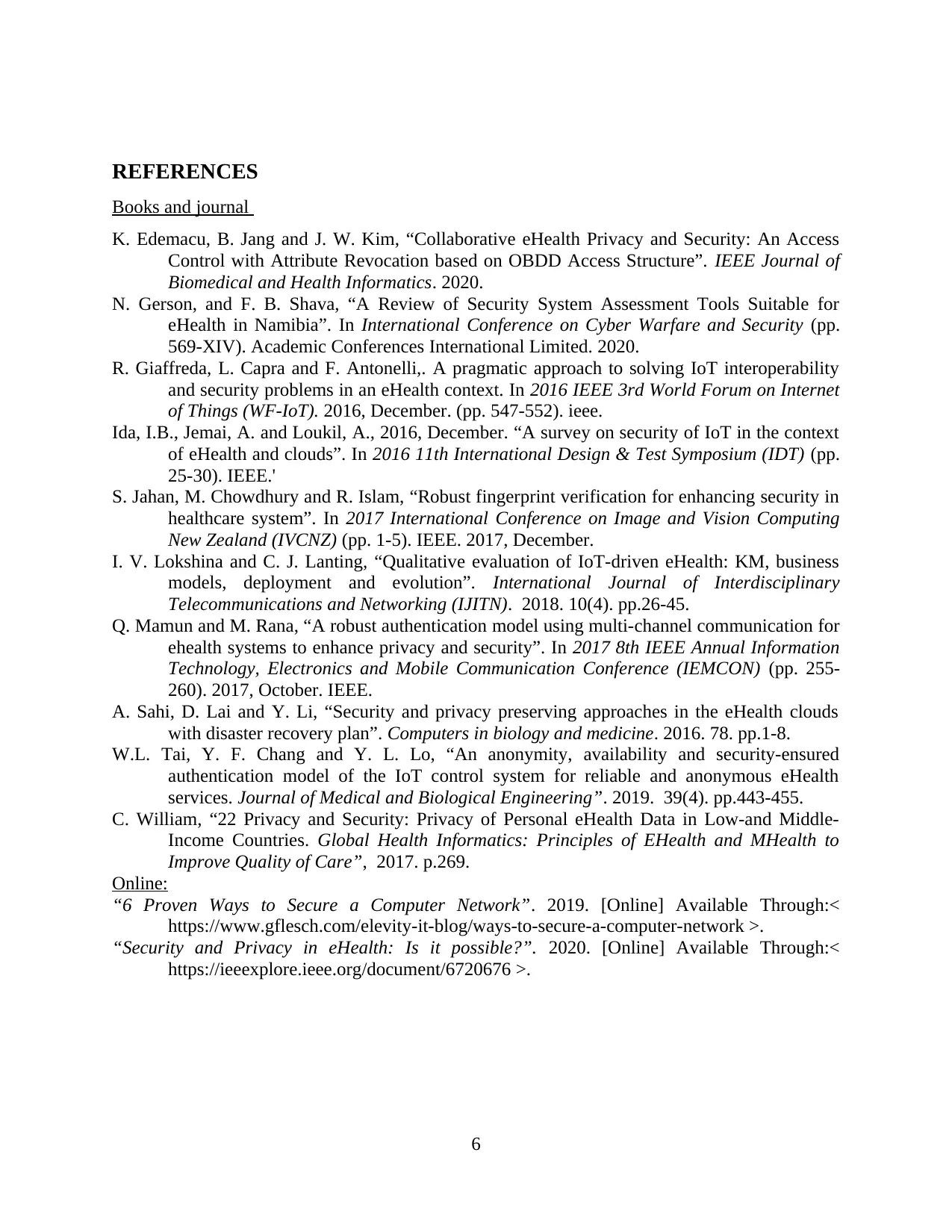
REFERENCES
Books and journal
K. Edemacu, B. Jang and J. W. Kim, “Collaborative eHealth Privacy and Security: An Access
Control with Attribute Revocation based on OBDD Access Structure”. IEEE Journal of
Biomedical and Health Informatics. 2020.
N. Gerson, and F. B. Shava, “A Review of Security System Assessment Tools Suitable for
eHealth in Namibia”. In International Conference on Cyber Warfare and Security (pp.
569-XIV). Academic Conferences International Limited. 2020.
R. Giaffreda, L. Capra and F. Antonelli,. A pragmatic approach to solving IoT interoperability
and security problems in an eHealth context. In 2016 IEEE 3rd World Forum on Internet
of Things (WF-IoT). 2016, December. (pp. 547-552). ieee.
Ida, I.B., Jemai, A. and Loukil, A., 2016, December. “A survey on security of IoT in the context
of eHealth and clouds”. In 2016 11th International Design & Test Symposium (IDT) (pp.
25-30). IEEE.'
S. Jahan, M. Chowdhury and R. Islam, “Robust fingerprint verification for enhancing security in
healthcare system”. In 2017 International Conference on Image and Vision Computing
New Zealand (IVCNZ) (pp. 1-5). IEEE. 2017, December.
I. V. Lokshina and C. J. Lanting, “Qualitative evaluation of IoT-driven eHealth: KM, business
models, deployment and evolution”. International Journal of Interdisciplinary
Telecommunications and Networking (IJITN). 2018. 10(4). pp.26-45.
Q. Mamun and M. Rana, “A robust authentication model using multi-channel communication for
ehealth systems to enhance privacy and security”. In 2017 8th IEEE Annual Information
Technology, Electronics and Mobile Communication Conference (IEMCON) (pp. 255-
260). 2017, October. IEEE.
A. Sahi, D. Lai and Y. Li, “Security and privacy preserving approaches in the eHealth clouds
with disaster recovery plan”. Computers in biology and medicine. 2016. 78. pp.1-8.
W.L. Tai, Y. F. Chang and Y. L. Lo, “An anonymity, availability and security-ensured
authentication model of the IoT control system for reliable and anonymous eHealth
services. Journal of Medical and Biological Engineering”. 2019. 39(4). pp.443-455.
C. William, “22 Privacy and Security: Privacy of Personal eHealth Data in Low-and Middle-
Income Countries. Global Health Informatics: Principles of EHealth and MHealth to
Improve Quality of Care”, 2017. p.269.
Online:
“6 Proven Ways to Secure a Computer Network”. 2019. [Online] Available Through:<
https://www.gflesch.com/elevity-it-blog/ways-to-secure-a-computer-network >.
“Security and Privacy in eHealth: Is it possible?”. 2020. [Online] Available Through:<
https://ieeexplore.ieee.org/document/6720676 >.
6
Books and journal
K. Edemacu, B. Jang and J. W. Kim, “Collaborative eHealth Privacy and Security: An Access
Control with Attribute Revocation based on OBDD Access Structure”. IEEE Journal of
Biomedical and Health Informatics. 2020.
N. Gerson, and F. B. Shava, “A Review of Security System Assessment Tools Suitable for
eHealth in Namibia”. In International Conference on Cyber Warfare and Security (pp.
569-XIV). Academic Conferences International Limited. 2020.
R. Giaffreda, L. Capra and F. Antonelli,. A pragmatic approach to solving IoT interoperability
and security problems in an eHealth context. In 2016 IEEE 3rd World Forum on Internet
of Things (WF-IoT). 2016, December. (pp. 547-552). ieee.
Ida, I.B., Jemai, A. and Loukil, A., 2016, December. “A survey on security of IoT in the context
of eHealth and clouds”. In 2016 11th International Design & Test Symposium (IDT) (pp.
25-30). IEEE.'
S. Jahan, M. Chowdhury and R. Islam, “Robust fingerprint verification for enhancing security in
healthcare system”. In 2017 International Conference on Image and Vision Computing
New Zealand (IVCNZ) (pp. 1-5). IEEE. 2017, December.
I. V. Lokshina and C. J. Lanting, “Qualitative evaluation of IoT-driven eHealth: KM, business
models, deployment and evolution”. International Journal of Interdisciplinary
Telecommunications and Networking (IJITN). 2018. 10(4). pp.26-45.
Q. Mamun and M. Rana, “A robust authentication model using multi-channel communication for
ehealth systems to enhance privacy and security”. In 2017 8th IEEE Annual Information
Technology, Electronics and Mobile Communication Conference (IEMCON) (pp. 255-
260). 2017, October. IEEE.
A. Sahi, D. Lai and Y. Li, “Security and privacy preserving approaches in the eHealth clouds
with disaster recovery plan”. Computers in biology and medicine. 2016. 78. pp.1-8.
W.L. Tai, Y. F. Chang and Y. L. Lo, “An anonymity, availability and security-ensured
authentication model of the IoT control system for reliable and anonymous eHealth
services. Journal of Medical and Biological Engineering”. 2019. 39(4). pp.443-455.
C. William, “22 Privacy and Security: Privacy of Personal eHealth Data in Low-and Middle-
Income Countries. Global Health Informatics: Principles of EHealth and MHealth to
Improve Quality of Care”, 2017. p.269.
Online:
“6 Proven Ways to Secure a Computer Network”. 2019. [Online] Available Through:<
https://www.gflesch.com/elevity-it-blog/ways-to-secure-a-computer-network >.
“Security and Privacy in eHealth: Is it possible?”. 2020. [Online] Available Through:<
https://ieeexplore.ieee.org/document/6720676 >.
6
1 out of 8
Related Documents
Your All-in-One AI-Powered Toolkit for Academic Success.
+13062052269
info@desklib.com
Available 24*7 on WhatsApp / Email
![[object Object]](/_next/static/media/star-bottom.7253800d.svg)
Unlock your academic potential
Copyright © 2020–2025 A2Z Services. All Rights Reserved. Developed and managed by ZUCOL.




